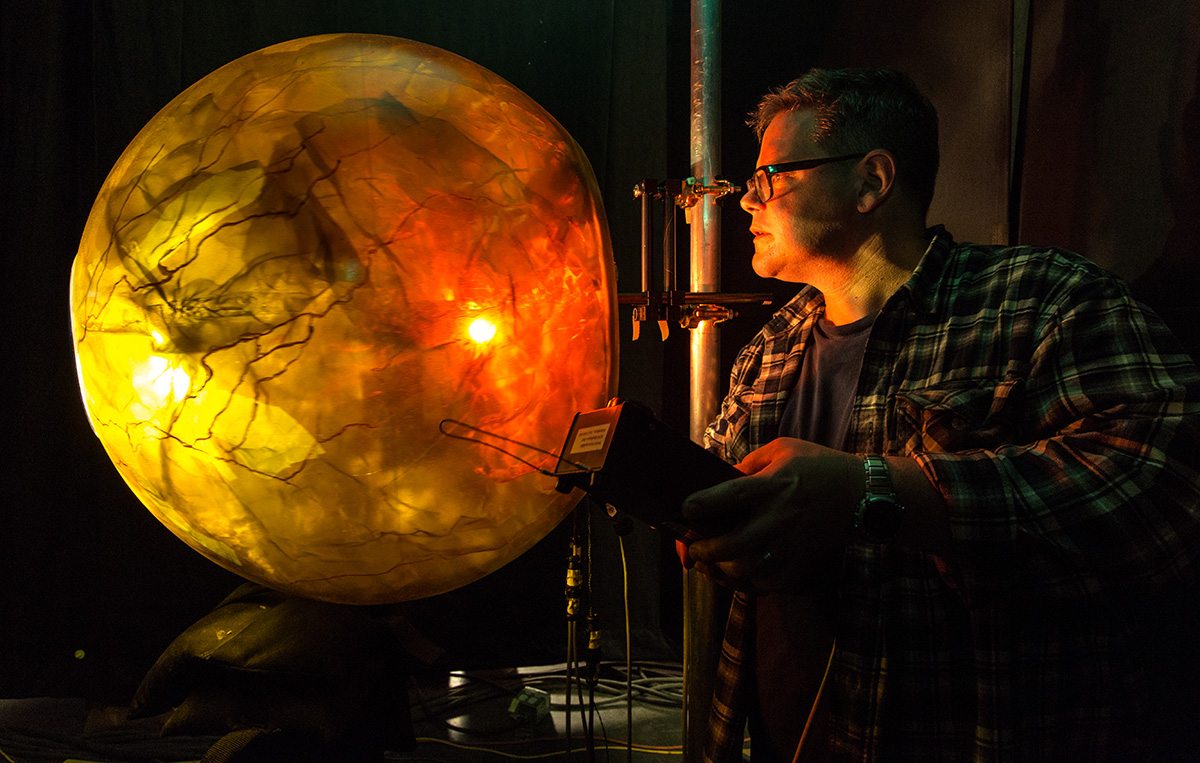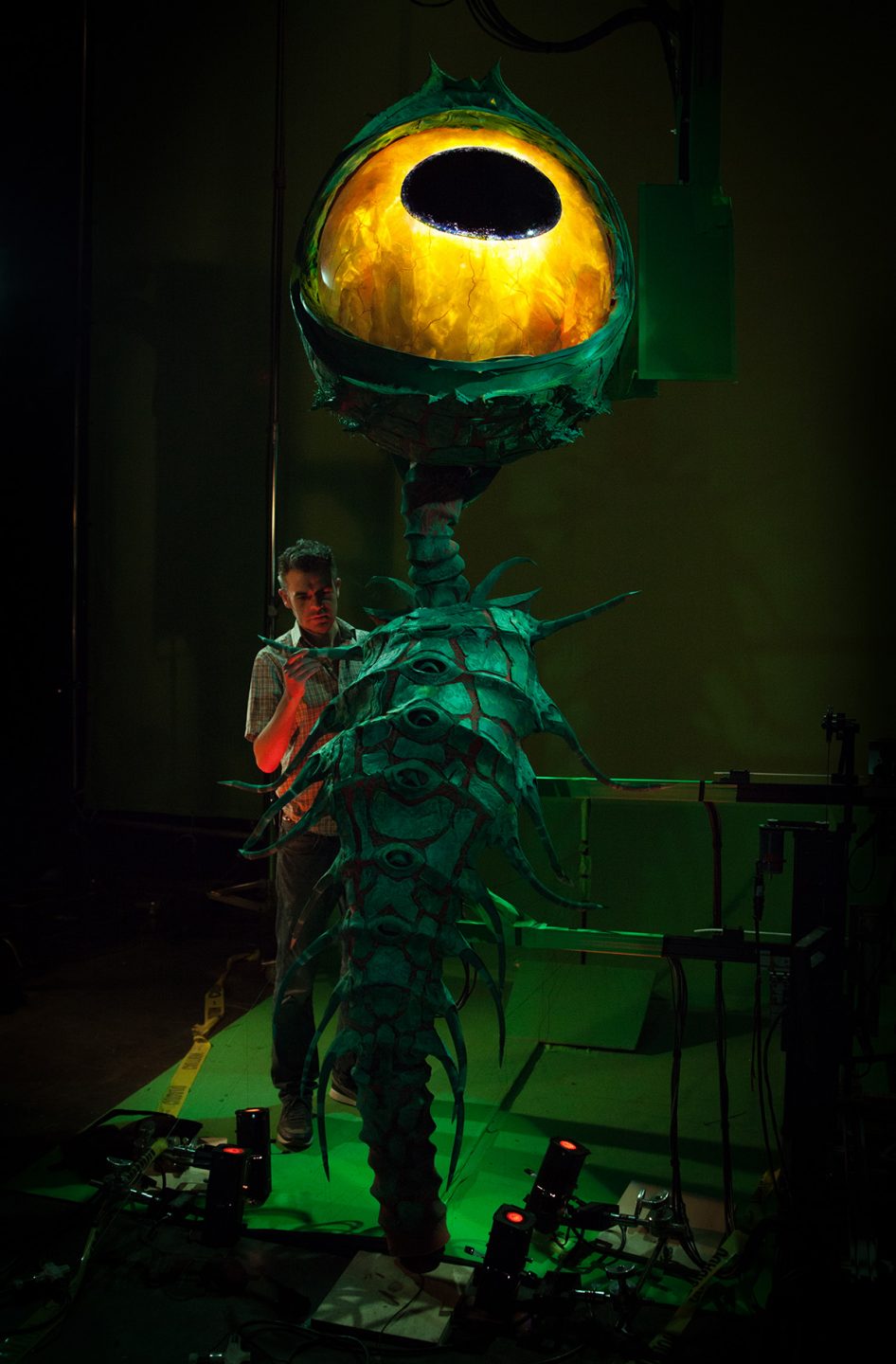How To Animate A Tenticle Frame By Frame
End motion is by its very nature one of the about easily-on kinds of animation. But how do you animate a giant underwater eyeball frame-by-frame? It's something Laika had to conquer for Kubo and the Two Strings. The solution rested with a bowling ball.
That's right, a bowling ball. And it was simply one of the techniques used to produce the crucial 'Garden of Eyes' sequence in the film, which besides involved significant model fabrication, traditional stop motion, digital institute life, cg h2o, greenscreen compositing, and other visual furnishings.
Cartoon Brew finds out more about the bowling ball solution, and other aspects of the sequence, from key members of the Laika coiffure.
Making the giant eyes
In the sequence, Kubo dives below the h2o surface in search of his father's magic armor. Simply he encounters a shoal of giant eyeballs. Laika's rigging department worked with the lighting and photographic camera departments to devise how the giant eyes would look. Simply one was built then replicated for the shoal.
"Essentially giant illuminated sclera on stalks, the creatures incorporated an array of LEDs seated behind the educatee, shining through counter-spinning rippled domes," said animation rigging supervisor Oliver Jones. "A 32-inch perspex brawl filled with a steel textile mesh picked upwardly the tiny specular flashes and swathes of cascading low-cal. The end result is an electric and mesmerizing moiré effect that hypnotizes both Kubo and hopefully the audience."

Since Kubo's terminate motility puppet was about six inches tall, the unabridged middle brute puppet had to be built at a size that would attain the correct scale. The result was that it stood at a hulking 11 anxiety. In guild to command the heart, Laika came upward with a semi-automatic solution – the bowling ball.
"Instead of moving the puppet by manus," explained Jones, "we devised intuitive remote interfaces for a stop motion animator. A bowling ball was transformed into a giant trackball with 2 hacked estimator mice translating the rotating coordinates into a iii-centrality rig that in turn rolled the puppet's floating middle. A miniature proxy puppet with 'off-lath' encoders controlled the body movements."
This robotic system meant animators did not demand to move each of the middle's 16 tentacles frame by frame. Here, instead of a traditional ball-and-socket armature, cables were tugged past stepper motors installed internally on a telescopic ribcage. "We choreographed a swim cycle nicknamed the 'Garden of Eyes dance' which supplemented the animators' key-frame performance," said Jones. "Pre-programming and recording animation dramatically cut down phase time."
The challenge of underwater
Since the sequence takes identify underwater, Laika had the boosted problem of making Kubo's kimono and his hair move realistically. Blitheness supervisor Brad Schiff turned to existent earth reference for guidance. "I went to our local gym at tiffin one day, and, wearing a kimono, jumped into the puddle shot and shot video reference of myself swimming around. It was incredibly useful to see how the fabric of the kimono and my pilus moved underwater. This reference informed how the kimono needed to be built to go the heavy flowing feel of being underwater."
The stop movement material kimono was originally crafted with extra support material and Tyvek bankroll (a kind of polyethylene cobweb used as a weather condition bulwark) and then that it didn't move effectually during animation. And so for the underwater version, this material was taken out and extra wire and foil placed in the sleeves, cuffs, collar, and ends of the kimono. "That gave the animator, Danail Kraev, the ability to go the finite organic shapes in the costume needed to emulate the look of it beingness underwater," said Schiff.
Of course, that was only part of the solution to make the shots look like they were happening underwater. Kelp plants in the scenes were too fabricated and rigged practically with fishing line to programmed stepper motors. They were then filmed under multiple lighting passes from several angles, and replicated by Laika's visual effects team to grade an all-encompassing library of submerged forest.

The vfx team was also integral in bringing all of the elements together – the eyes, kelp, and characters which were sometimes animated separately against greenscreen. "The art section was very specific with the layout of the environment as well every bit the calibration of the kelp and monsters relative to the puppets," said visual furnishings supervisor Steve Emerson. "Timur Khodzhaev was the sequence lead. He set upwardly a system in Nuke then that we could get authentic depth for plankton. And then, along with senior compositor Ralph Procida, worked very closely with the art department and photographic camera team to dial in the colour, atmosphere, and volumetrics."
Although an try had been made to cease motion animate Kubo's pilus for an underwater feel, it was determined to do a cg replacement afterward some early tests. "That allowed the stage animators to focus on material and puppet move," said Emerson. "Information technology's the just hair replacement that we did in the film. All other puppet pilus performances were done in-photographic camera past the stage animators."
Shot breakdown – Kubo faces the eye
At ane point, Kubo has a straight come across with one of the giant optics. It puts him into a hypnotic state that leads him downwards towards the monster'southward enormous oral cavity.

"The original storyboards showed Kubo's eye turning white, only director Travis Knight was interested in exploring other options," related Emerson. "Our lead compositor, Michael Cordova, came upward with many ideas, but the 1 that Travis really responded to was a dilating pupil that transitioned into the wait of the Garden of Eyes monster eyeball. He did it all in 2D. He sourced a plate of the monster blitheness, extracted the eyeball portion, then warped, tracked, and integrated information technology onto the Kubo puppet."
This shot, peradventure more than most, emphasizes the fashion Laika has never shied abroad from taking advantage of as many resource equally possible to bring its films to life. This means that both practical and digital methods were considered. Indeed, so critical are the digital methods that Kubo is amidst the 10 shortlisted films nether consideration for the all-time visual furnishings accolade at the Oscars.
"I'm really proud of the underwater piece of work that nosotros did for Kubo and the Two Strings," said Emerson. "Mostly, in that so much of it was realized through inter-departmental collaboration across the studio. There's something most having terminate motion animators, set builders, and puppet makers collaborating with digital artists that takes us into some really unique visual territory."
Source: https://www.cartoonbrew.com/feature-film/laika-used-bowling-ball-animate-giant-eyes-kubo-two-strings-146172.html
Posted by: castillejaevembee1956.blogspot.com

0 Response to "How To Animate A Tenticle Frame By Frame"
Post a Comment